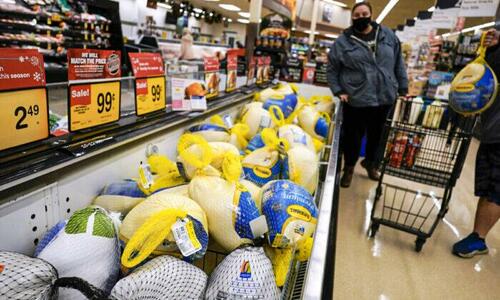Authored by Andrew Moran via The Epoch Times,
It is going to cost more to feast on turkey, ham, and mashed potatoes at this year’s Thanksgiving dinner.

According to the American Farm Bureau Federation (AFBF), the typical Thanksgiving dinner includes the staples of a 16-pound turkey, a gallon of milk, potatoes, ham, and dinner rolls.
U.S. Department of Agriculture (USDA) data (pdf) show that an 8- to 16-pound turkey costed $1.99 per pound last week, up from $1.15 a year ago. This represents almost a 75 percent increase.
Boneless ham has increased 13.6 percent in September from a year ago to $5.50 per pound, data from the Bureau of Labor Statistics (BLS) show. White potatoes have spiked 27.7 percent to $1.02 per pound, while white bread has climbed 10.7 percent to $1.75 a pound. A gallon of fresh whole milk has surged 16.6 percent to $4.18.
The wide range of miscellaneous ingredients has also increased at a significant rate over the last year, including butter (26.6 percent), flour (24.4 percent), spices and seasoning (13.8 percent), sugar (17.1 percent), sauces and gravies (16.3 percent), and coffee (15.7 percent).
Overall, food prices have soared over the last year, with the BLS food index climbing at an annualized pace of 11.2 percent. Grocery store prices spiked 13 percent year-over-year in September, while the cost of visiting a restaurant has risen 8.5 percent compared to the same time a year ago.
People shop at a grocery store in New York City on May 31, 2022. (Samira Bouaou/The Epoch Times)
Soaring food prices have been driven by a broad array of factors, including volatile weather conditions in key growing areas, the Ukraine-Russia conflict, surging energy prices and labor costs, and the Avian flu.
Bird Flu
The continued Avian outbreak has impacted the price and supply of turkey, chicken, and eggs. The highly pathogenic avian influenza (HPAI) virus usually occurs in the colder months, but commercial turkey producers contended with the bird flu in July. This is the time when farmers begin raising flocks for the coming holiday season.
So far this year, nearly 48 million birds have been affected, with the flu identified in 42 states. The only way to limit its spread is to kill entire flocks, which consist of approximately 15,000 birds.
The issue is not only widespread in the United States. There are a vast number of bird flu cases being reported in Canada, Mexico, the United Kingdom, and the European Union. Millions of birds have been culled as a result.
Experts purport that transmission has increased immensely over the last year, and the illness is spreading to mammals at a faster pace. Scientists are unsure why the outbreak is intensifying, but some theories argue that mutations have let the virus infect a variety of bird species, and the mutations have allowed the virus to replicate.
“All of us are feeling the pain of higher prices at the grocery store,” said AFBF President Zippy Duvall in a statement.
“HPAI outbreaks in the spring and an uptick in cases in the fall are taking a toll, but farmers remain dedicated to ensuring America’s food supply remains strong.”
Meanwhile, another aspect has been the notable 8.1 percent year-over-year increase in turkey feed prices. This is in addition to rising energy, fertilizer, and labor costs that farmers are facing.
The USDA’s latest Farm Sector Income Forecast anticipates record-high total overall production costs, skyrocketing nearly 18 percent from 2021 to $437.4 billion this year.
Can Americans Afford Thanksgiving?
Continue Reading: zerohedge.com






Leave a Reply